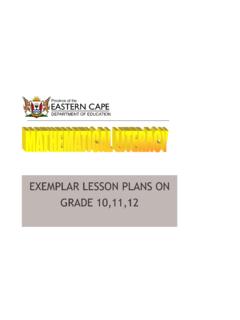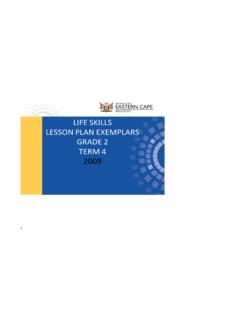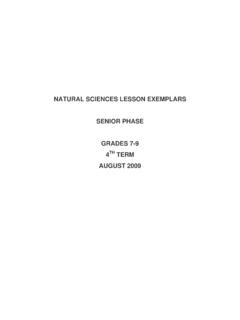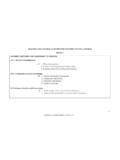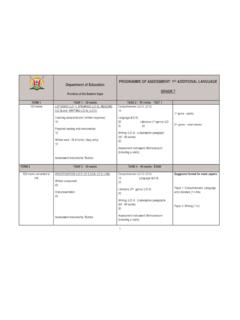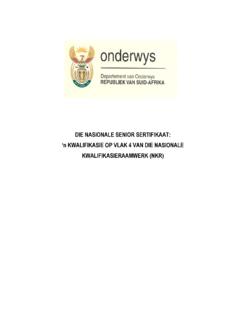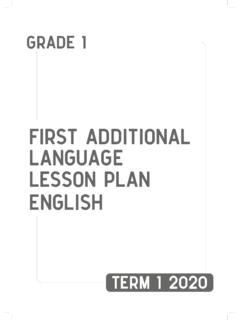Transcription of FIRST ADDITIONAL LANGUAGE LESSON PLAN ENGLISH
1 grade 4. FIRST ADDITIONAL . LANGUAGE . LESSON PLAN. ENGLISH . Term 2 2020. FOREWARD. Dear Intermediate Phase Teachers, Welcome to Term 2 of the PSRIP! We do hope that by now, the routine and core methodologies are more familiar to you, and that you are enjoying the programme. Please remember that the focus of this programme is to ensure that all learners can read, and that they can read with understanding. Because of this, remember to focus on: Technical decoding revising ENGLISH phonics, blending and segmenting with learners Improving fluency always model fluent reading for your learners; read with the correct pace, intonation and expression Building vocabulary and general knowledge this helps learners to anticipate and recognise words, but it also helps them to understand what they are reading Building comprehension skills model and explicitly teach the skills of prediction, searching the text, making comparisons, making evaluations, making inferences and of summarising.
2 We wish you all a happy and successful term, and we thank you most sincerely for your commitment to this programme! Best wishes The PSRIP Team 2 grade 4 ENGLISH FIRST ADDITIONAL LANGUAGE . CONTENT. MANAGEMENT Materials and Resources 5. Cycle 6. Cycle 7. Themes and Reading 8. Term 2 Programme of 9. EFAL Theme CORE Phonics Listening Speaking Oral 1. Oral Activities: Song / Rhyme / 2. Oral Activities: Theme 3. Oral Activities: The Question of the Shared Reading & Teaching the Comprehension FIRST Second Teach the Comprehension Group Guided What to do with the rest of the class:..30. Structure of the Group Guided Reading Assigning groups and text selection:..32. What to do with each group during Group Guided Teach the Plan the LSC and Editing and Writing Week 1 - Week 2 - Week 3 - Going Week 4 - Going Week 5 - Incredible 115. Week 6 - Incredible Insects .. 134. Week 7 - 154. Week 8 - Butterflies .. 174. Week 9 - 190. Week 10 - 190.
3 LESSON PLAN: TERM 2 3. LEARNING OUTCOMES. Term 2 Learning Outcomes This term, learners should achieve the following outcomes in EFAL: Listening & Speaking Learners should be able to say or sing 4 new rhymes or songs Learners should be able to discuss the listening text using a conversation frame Learners should be able to orally summarise the text that has been read Learners should be able to talk about their writing Learners should understand and be able to use some of the following vocabulary misunder- private conversation overhear overheard nosy standing message beware curious confused urgent fluent fluently accident accidently corrected country heat Valentine's holiday code competition onlooker prize Day compart- collected donate advertisement stylish organised ments available expensive cheap exhausted relaxed dreamed starving fridge cupboard addiction credit card insect fascinated expert crime intelligent thorax abdomen magnifying antennae microscope sting beehive pollen glass snail slimy sickness creature beetle pincers concentrate judgemental
4 Judge peered cocoon wriggling identical caterpillar fuzzy flapping graceful magical miserable species hatch unique pattern life cycle attach stage usually Reading: Learners should be able to decode the following words, or other words that use the phonic sounds revised chain chop chat chip chick chart rain pain mail sail train trip trust trail trick bird shirt skirt girl thin thick think with third thank tray pray stay pay say bring brick brat brush sing ring sung song long wing fling 4 grade 4 ENGLISH FIRST ADDITIONAL LANGUAGE . LEARNING OUTCOMES. Reading: Learners should be able to read the following words by sight ran towards fast laugh help could thought since meant answer different usually finally going herself quietly woke bought himself can't don't who with use type because female around instead being scared people interesting weight notice fight Reading: Learners should be able to read a connected text at an appropriate level, for example: My mother's old friend My mother was friends with a very old lady in her village, Mrs Gumede.
5 Mrs Gumede was sick and in bed. On Thursday, my mother was worried. She had not seen Mrs Gumede since Monday. Thabo, I am worried,' my mother said to me. Go and find out how old Mrs Gumede is.'. So, I went to Mrs Gumede's house to see her. When I got back, my mother met me at the door. And?' asked mother. What did Mrs Gumede say?'. She was angry,' I answered. Mrs Gumede said it is none of your business how old she is. She wants to know when you are going to see her.'. Haibo Thabo!' said my mother. You are a silly boy! I told you to see how Mrs Gumede is feeling!'. Reading: Comprehension 1. Learners should be able to make predictions about a story by skimming and scanning a text and identifying key words 2. Learners should be able to recall details about a story 3. Learners should be able to sequence events in a story 4. Learners should know what it means to visualise, make connections, make inferences, make evaluations and wonder about the text 5.
6 Learners should be able to summarise and retell the story 6. Learners should be able to use sentence starters to answer comprehension questions in writing Writing 1. Learners should be able to plan, draft, edit, publish and present their writing 2. Learners should be able to use their plans to complete 2 paragraphs 3. Learners should know the format to write a newspaper article, a descriptive essay, in- structions and a haiku poem. LESSON PLAN: TERM 2 5. MANAGEMENT NOTES. Materials and Resources Provided Please note that all resources provided belong to the school. In Term 2, the PSRIP provides you with the following resources: ITEM QUANTITY NOTES. Use this LESSON plan to see what to teach on a daily basis. The core methodologies included tell you how to teach Term 2 LESSON Plan 1. each LESSON . For the last two weeks of Term 2, you will be doing formal assessments. Use this document to complete your ATP and Term Term 2 Tracker 1 Planner.
7 Tick off and date each LESSON and assessment activity as it is done. Reflect on your teaching. The resource pack includes all the flashcard words and theme vocabulary illustrations required. It now also includes some Phonics Reading Worksheets' that may be Term 2 Resource 1 used with learners who are struggling to read. Cut them Pack up and store them in an orderly fashion. Display these words and illustrations for the two weeks that you teach the theme. Term 2 Reading Use these worksheets with all learners during group 4. Worksheets guided reading. 6 grade 4 ENGLISH FIRST ADDITIONAL LANGUAGE . Cycle Routine COMMON ROUTINE: grade 4-6. MONDAY / DAY 1 TUESDAY / DAY 2 WEDNESDAY / DAY 3 THURSDAY / DAY 4 FRIDAY / DAY 5. L&S / LSC L&S L&S / LSC R&V R&V. THEME INTRO SPEAKING ACTIVITY ORAL ACTIVITIES SHARED READING: SHARED READING: ORAL ACTIVITIES SECOND READ POST-READ. L&S R&V R&V / LSC R&V W&P. LISTENING ACTIVITY PHONICS REVIEW SHARED READING: TEACH TEACH THE GENRE.
8 SHARED READING: FIRST READ COMPREHENSION. PRE-READ LSC IN CONTEXT STRATEGY. MONDAY / DAY 1 TUESDAY / DAY 2 WEDNESDAY / DAY 3 THURSDAY / DAY 4 FRIDAY / DAY 5. W&P L&S W&P /LSC L&S W&P. PLAN WRITING ORAL ACTIVITIES TEACH LSC ORAL ACTIVITIES EDIT & PRESENT. DRAFT WRITING WRITING. R&V R&V R&V R&V R&V. GROUP GUIDED GROUP GUIDED GROUP GUIDED GROUP GUIDED GROUP GUIDED. READING READING READING READING READING. & COMPREHENSION & COMPREHENSION & COMPREHENSION & COMPREHENSION & COMPREHENSION. L&S: 2 HOURS; LSC: 1 HOUR, R&V: 5 HOURS; W&P: 2 HOURS. LESSON PLAN: TERM 2. 7. MANAGEMENT NOTES. MANAGEMENT NOTES. Cycle Preparation It is important to remember that the PSRIP programme has reduced the need for teachers to PLAN, but that PREPARATION is still required! One afternoon per week, get together with your colleagues (all Intermediate Phase EFAL. teachers), and do your preparation together. When doing your preparation, remember to: 1. Read through the LESSON plan for the cycle.
9 2. Make sure that you know and understand the methodologies that must be used. If not, go to the section titled Core Methodologies' and revise accordingly. 3. Next, check which flashcardsand illustrationsare needed for theme vocabularyand the writing frame. Get these flashcards and illustrations ready as follows: Cut the flashcards or illustrations out Try to stick them onto cardboard or paper If possible, laminate or cover in plastic Store theme flashcards together in an envelope, or with a rubber band around them 4. Prepare your Worksheets for the cycle. Slip a Worksheet into a plastic sleeve for each learner / pair of these ready to use in the second week of each cycle. 5. Collect any other resources that you may need, including pictures or real objects. 6. Read through any the activities in the DBE Workbook that you will complete. Pay attention to the text that will be read for the SHARED READING lessons. 7. Practice doing the writing lessons.
10 It is also a good idea to see that your Tracker is up-to-date from the previous week, and that you have completed all activities and ticked them off in the Tracker. Keep your Group Guided Reading Groups up to date. Finally, if you are doing any formal assessments that week, read through the rubrics and make sure that you know what to do. 8 grade 4 ENGLISH FIRST ADDITIONAL LANGUAGE . MANAGEMENT NOTES. Themes and Reading Schedule WEEK LITERATURE INDEPENDENT. THEME LISTENING TEXT. NUMBER TEXT READING TEXT. 1 DBE Workbook 1 page 104: Frog A Private Week 2. Misunderstandings and Crow get the Conversation Worksheet 2 wrong message 3. DBE Workbook 1 Vuyo Tshabalala Week 4. Going Shopping page 92: Buying a (45) Wins Worksheet Backpack Shopping Prize 4. 5. DBE Workbook Bernard Week 6. Incredible Insects page 112: What do Greenberg Worksheet insects look like? 6. 7 DBE Workbook Butterflies & 1 page 128: Week 8. Judgemental Judy Assessment Butterflies flutter Worksheet 8 by 9.
